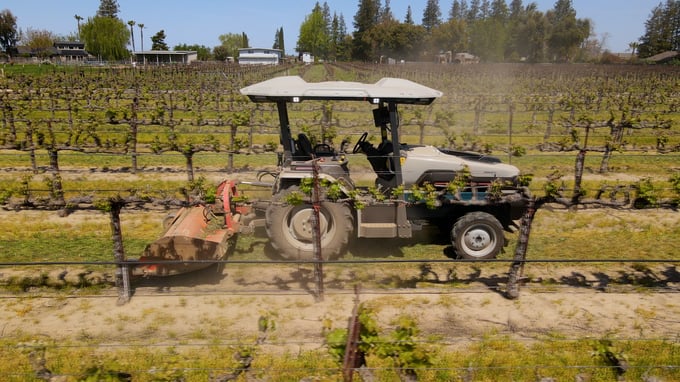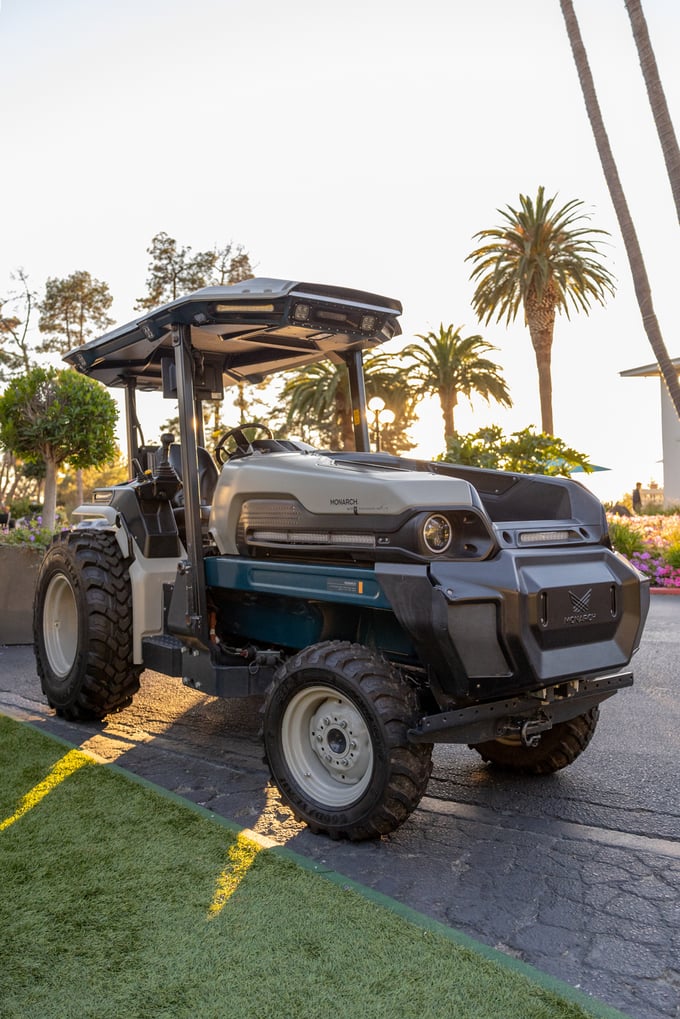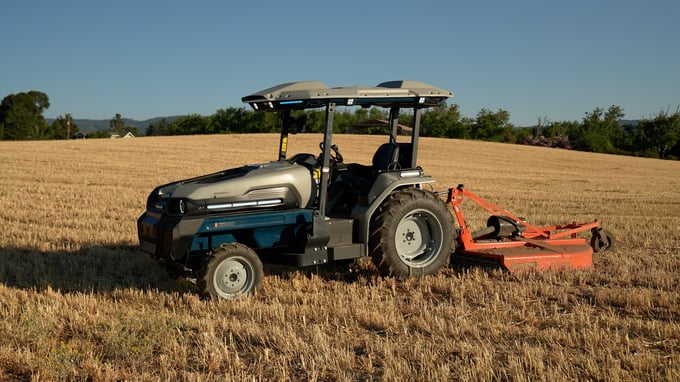Lawns, an iconic fixture of American landscaping, blanket the suburbs, provide lush surfaces for park picnics, and give athletes across the country ground cover for field games in stadiums, golf courses, and schools. Much of this vast, manicured green comes from sod farms. A sod farm, also called a turf grass farm, is an agricultural operation dedicated to growing and harvesting grass that can be transported then unrolled for the instant transplantation of a living, green lawn or expansive turf.
But just like their produce-growing colleagues, sod farming faces many challenges and those in the industry are looking for ways to stay ahead of demand and profitability. One strategy catching the attention of sod farms is the use of an electric, autonomous tractor.
Why Are Sod Farms Important?
Sod farming is a major part of residential, public, and commercial property development, meeting the needs of developers, planners, and homeowners who desire a certain aesthetic and functionality in their landscaping. In new construction sites, turf grass farming provides an affordable resource in preventing soil erosion and helping regulate temperatures in urban and suburban “heat islands” caused by blacktop and lack of vegetation.
Sod also plays an important role in the U.S. ag economy. According to the 2017 U.S. Department of Agriculture (USDA) Agricultural Statistics Survey, the U.S. natural grass sod industry was valued at over $1.1 billion, produced on 1,465 farms on 339,451 acres across 49 states. In short, it’s a significant specialty crop and has piqued the interest of newcomers to the market who are asking how to start a sod farm. 
What Are Some Main Challenges in Sod Farming?
Like many growers, sod farming faces several challenges related to harvest timing, weather and seasonality, and labor shortages.
1. Harvest Timing
Timing is critical in sod farming as the harvest window is narrow. Cutting the sod too early or too late can significantly impact its quality and yield. Sod needs to reach maturity before harvesting. Bermuda grass and Kentucky bluegrass, two common sod varieties, can take anywhere from 10 months to two years to reach maturity. Harvesting too early results in immature sod that may not establish well, while delaying the harvest can lead to overgrown and root-bound sod.
Timing is also critical regarding delivery logistics between a turf grass farm and a customer. Sod must be harvested to order and not stockpiled, as it can quickly deteriorate in hot weather if left on pallets for extended periods. Precise coordination between sod farm harvesting and delivery schedules ensures the sod reaches customers in optimal condition and avoids decomposition. 
2. Weather & Seasonality Challenges
Weather conditions and seasonal variations can significantly impact sod growth and quality. Drought conditions stresses sod and reduce yields. Excessive rainfall, on the other hand, increases the likelihood of disease and mold. Sod farming is also heavily influenced by seasonal changes, with growth rates and harvest windows varying throughout the year. In colder climates, the growing season may be limited, necessitating careful planning and management to maximize production during the optimal months. Furthermore, weather extremes and unpredictable patterns can disrupt field operations, such as planting, fertilizing, and harvesting, leading to delays and potential yield losses.
3. Labor Shortages
Like many agricultural sectors, sod farming faces significant labor challenges. Finding reliable and skilled employees to work on the farm or complete installation jobs can be a major hurdle. The physically demanding nature of sod farming, coupled with the seasonal workload fluctuations, can make it difficult to attract and retain a consistent workforce.
Labor shortages can impact various aspects of sod farming operations, from field work to delivery and installation. Without sufficient labor, tasks such as mowing, harvesting, stacking, and loading sod onto trucks may be delayed or compromised, leading to potential losses and customer dissatisfaction. Additionally, the availability of skilled labor can be a concern for tasks that require more specialized knowledge or experience.
What Are Autonomous, Electric Tractors?
A fully autonomous electric tractor is a self-driving, battery-powered agricultural vehicle designed to operate without a human driver on board. These tractors are equipped with advanced technologies such as GPS, cameras, sensors, and artificial intelligence (AI) systems that allow them to navigate fields, perform tasks like mowing, seeding, and cultivating, while making decisions autonomously, such as stopping when detecting a human or object near the tractor. 
True autonomy in a tractor is complex technology and as of 2024, Monarch Tractor is the only manufacturer that has successfully brought its autonomous, electric MK-V tractor to market. Fully autonomous operations require training the tractor to negotiate many variables including different crop types, implements, headland space, row width, and topography all while maintaining stringent safety standards and operational accuracy. Monarch is releasing autonomy in stages to ensure success for farms. Because the MK-V is engineered with software-enabled hardware, the tractor can be updated with new features and improvements, which are pushed to the tractor with over-the-air updates. Developments are released to expand capabilities to new crops and operational parameters. As of 2024, Monarch is actively targeting Autodrive in open field mowing for sod farms.
Some tractors incorporate advanced driver assistance systems (ADAS), which provide a version of partial autonomy to operations. With ADAS, a person must remain seated in the driver’s seat, but the tractor can handle certain aspects of the operation automatically, such as keeping itself aligned within a row while using an implement. Many modern passenger vehicles on the roads today are equipped with various ADAS features and it’s likely you’re already utilizing this technology regularly without realizing it. ADAS in passenger cars assist with tasks like adaptive cruise control, lane keeping, and automatic emergency braking. While many tractors utilized in large-scale industrial farms have a semi-autonomous autosteer feature, Monarch is the first to bring this feature (which it calls Row Follow) and the benefits that go with it, to small specialty farms.
What Role Can Autonomous Electric Tractors Play in Sod Farming?
As turf grass farms grapple with increasingly over-stretched farmhands and farm budgets, they are looking at new strategies to help them stay ahead. Deploying an autonomous, electric tractor is emerging as a potential high-value solution. A tractor that pairs electrification and full autonomy, such as the MK-V is doing, can play a significant role in sod farming by improving resource efficiency, ensuring precision, helping alleviate labor concerns, and reducing the burden of meeting stringent environmental standards.
Resource Efficiency
Sod farmers must meet daily mowing requirements to keep the grass at optimum height. This height varies depending on the species, but keeping the grass contained within targeted height parameters requires constant attention. Meeting efficiency targets is key to profitability. For an electric tractor to be of any value on a sod farm, it must meet that farm’s efficiency targets. The MK-V, assuming a 12-hour workday with a short charge cycle during lunch, is performing 80-120 acres of mowing per day dependent on implement size.  When an electric tractor can meet efficiency targets, a sod farm is positioned for other resource efficiency gains enabled by an EV tractor. Reduced fuel consumption and zero emissions supports lower operating costs. Not only do electric tractors eliminate the need for diesel, but the electric power economics of charging and running an electric tractor is far less than that of running a diesel tractor. Furthermore, electric autonomous tractors have lower maintenance costs compared to traditional diesel tractors. Their electric motors are more efficient and have fewer moving parts than a conventional internal combustion engine, which decreases maintenance requirements.
When an electric tractor can meet efficiency targets, a sod farm is positioned for other resource efficiency gains enabled by an EV tractor. Reduced fuel consumption and zero emissions supports lower operating costs. Not only do electric tractors eliminate the need for diesel, but the electric power economics of charging and running an electric tractor is far less than that of running a diesel tractor. Furthermore, electric autonomous tractors have lower maintenance costs compared to traditional diesel tractors. Their electric motors are more efficient and have fewer moving parts than a conventional internal combustion engine, which decreases maintenance requirements.
Precision
With GPS guidance, sensors, and 360-degree camera vision, an autonomous tractor like the MK-V operates with a high level of precision, performing tasks like mowing with great accuracy. Its precise guidance systems and consistent pacing optimized by algorithms also minimize overlapping passes, further boosting efficiency. When multiplied over the number of acres mowed on a sod farm, reducing or eliminating overlap in passes quickly add up to additional fuel and time savings.
Through its Wingspan Ag Intelligence (WingspanAI) technology, the MK-V enhances visibility on tractor operations, reporting metrics such as distance covered, hours of operation, average speed, energy used, and carbon emissions savings by each tractor. Insights such as these empower a farmer to make decisions based on data, not best guesses. 
Labor Savings
Autonomous tractor operations allow a single tractor operator to monitor multiple tractors remotely, reducing labor demand and associated costs. Having one operator monitor multiple tractors frees up labor to focus on other timely tasks like planting, harvesting, and transporting sod rolls to customers. Because labor is difficult to attain, sod farms can stretch their limited staff and budget without sacrificing productivity. Scalability and adaptability for the sod farm is more easily achieved as well, as autonomous tractor fleets can scale up or down to manage varying sod acreage. A sod farmer simply adds or removes tractor units to adjust to workload needs without being constrained by the availability of skilled labor.
Labor savings are also realized in advancing an operator’s skill level. Because of an autonomous tractor’s inherent precision, sod farmers can quickly train a new operator who may lack years of experience to mow with high levels of efficiency and exactitude. Monarch has taken great care to make its Autodrive system easy to understand so operators familiar with diesel tractors can feel comfortable and confident monitoring multiple high-tech electric, autonomous tractors.
Environmental Compliance
Diesel tractors pose a challenge to sod farmers because of frequency and cost associated with Environmental Protection Agency (EPA) Tier 4 emissions repairs and compliance. Tier 4 EPA emissions regulations are the strictest emissions standards set for off-road diesel engines and aim to significantly reduce emissions of particulate matter and nitrogen oxides from off-road diesel engines, like tractors. The electric drivetrain of an EV tractor produces zero emissions, eliminating the costs and hassles of Tier 4 emissions compliance.
Eliminating diesel emissions is a positive for a safer and healthier work environment for operators. Full autonomy brings safety to a whole new level. Removing human operators from the tractor seat eliminates risks of roll-overs, collisions, and PTO entanglements, creating safer working conditions.
Common Concerns
Implementing an electric autonomous tractor on sod farm introduces a few concerns for turf grass farmers:
Battery Run Time & Charging
Electric tractors have limited battery life and the lack of familiarity with newer battery technology leaves many farmers wary of overall run time. It’s understandable. Sod farms require continuous work and inability to meet operational needs risks hardship. With adequate charging infrastructure, Monarch’s MK-V has demonstrated runtime of up to a full workday of operations based on farm, operation, and implement.
Horsepower
The question of whether an electric tractor has enough horsepower to meet a sod farm’s efficiency standards is top of mind for many farmers. While it’s true that diesel tractors possess a higher horsepower (HP), what many farmers don’t realize is that the by-wire system allows an EV tractor to more quickly switch the power distribution between the drivetrain, hydraulics, and PTO than that of a diesel tractor. This means better responsiveness when the tractor needs extra power to one of those three systems, e.g., traction.  Monarch has taken this flexibility in power distribution to a new level, literally. In the MK-V, the motor was selected to have a much higher HP than each of the individual components require, allowing an additional 30 HP be available to each system. As a result, each system draws what it needs, adjusting and adapting to the needs of an operation. With an MK-V electric tractor is marketed at 40-70 HP, the tractor can deliver 40 HP at the PTO continuously. The moment more HP is needed by either the drivetrain or PTO, the additional 30 HP is available. The difference between a maximum 70 HP and maximum subsystem (40 HP) is higher than that of a comparable diesel.
Monarch has taken this flexibility in power distribution to a new level, literally. In the MK-V, the motor was selected to have a much higher HP than each of the individual components require, allowing an additional 30 HP be available to each system. As a result, each system draws what it needs, adjusting and adapting to the needs of an operation. With an MK-V electric tractor is marketed at 40-70 HP, the tractor can deliver 40 HP at the PTO continuously. The moment more HP is needed by either the drivetrain or PTO, the additional 30 HP is available. The difference between a maximum 70 HP and maximum subsystem (40 HP) is higher than that of a comparable diesel.
Additionally, many common implements used on specialty farms don’t require a full 85 HP. Many farmers have found an EV tractor’s instant torque outperforms that of a comparable diesel tractor, a particularly helpful feature. However, demanding a consistently higher HP shortens the run time, though in many cases, not enough to negatively impact a workday. The MK-V has been successfully tested using typical sod farm implements and demonstrated reliable run time to meet the farm’s needs. Sod farms also tend to be flat, which also optimizes tractor run time.
Bottom line; when comparing an EV tractor to a diesel, there is more to HP than the advertised number. At the same time, talking to an EV tractor sales rep or dealer is important to ensure an electric tractor’s power matches a farm’s operational needs.
Tractor Price
The initial cost of electric autonomous tractors is typically higher than that of comparable conventional, diesel tractors and this upfront capital investment could be a barrier for some sod farm owners. While a tractor’s upfront purchase price is the initial expenditure, the true cost includes recurring operational and maintenance expenses against the tractor’s potential to improve profitability. The long-term savings of an electric, autonomous tractor is highly appealing to sod farmers. .jpg?width=6787&height=2189&name=MT_Feb24_SOD-Florida-09%20(1).jpg)
Sod Farm Success Strategy
An electric autonomous tractor can significantly contribute to the success of a sod farm. It reduces labor costs, enhances labor performance, increases efficiency, and eliminates emissions, promoting sustainability. With precise navigation and consistent performance, an autonomous tractor can optimize sod production. As technology advances, adopting electric autonomous tractors will give sod farms a competitive edge by reducing operational costs and environmental impact while strengthening farm resiliency against ongoing challenges.
References:
USDA National Agricultural Statistics Service, 2017 Census of Agriculture. Complete data available at www.nass.usda.gov/AgCensus.




